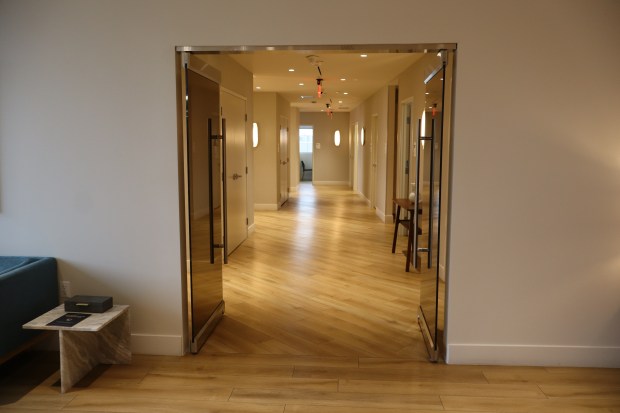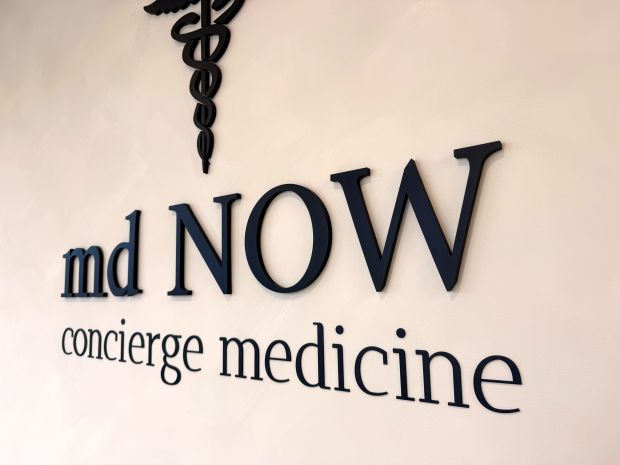It probably says something about me that my social media feeds think I need urgent care.
They’re not wrong, of course. Because, sure enough, when an Instagram ad for Manhattan Beach’s Sollis Health popped up — showing a picture of a luxe “members-only” urgent care that looked equal parts clinic and spa — I was intrigued:
“No Waits.”
“Top ER Doctors.”
“Unlimited Visits.”
Readers, I clicked.
Dr. Mike Tarnay, Sollis Health. (Photo courtesy of Melissa Heckscher)

Sollis Health lobby. (Photo courtesy of Melissa Heckscher)

Hallway at Sollis Health. (Photo courtesy of Melissa Heckscher)

Sollis Health robes. (Photo courtesy of Melissa Heckscher)

Sign for mdNOW concierge medicine. (Photo courtesy of Melissa Heckscher)
Show Caption
1 of 5
Dr. Mike Tarnay, Sollis Health. (Photo courtesy of Melissa Heckscher)
Because I’m that person who actually likes going to the doctor. That person who’s not afraid of a late-night emergency room visit if it means having peace of mind. That mom with three kids who swap germs faster than a whack-a-mole game.
So, yes. I was curious about this fancy-looking medical respite that seemed to offer a better option than my usual, crowded, long wait with a Kleenex box.
But Sollis Health isn’t a health care unicorn. It’s part of a growing wave of membership-based care — also known as concierge medicine — that offers upgraded medical care in exchange for monthly or annual fees.
For those who can afford it, the perks are obvious: same- or next-day appointments, shorter waits, direct lines to physicians, expedited referrals, and the option to see the doctor, basically, whenever you want to (most memberships include unlimited visits).
Urgent care, upgraded
Sollis has everything a typical urgent care may offer, including an on-site lab, basic imaging, stitches and splints, intravenous hydration, virtual visits, house calls, an X-ray machine, round-the-clock virtual care options, and hands-on coordination with specialists and hospitals, not to mention cushy perks like cloth robes in the exam rooms — which are pristine, with shiny wooden floors — and hot tea and coconut water in the lobby.
Sollis’s Manhattan Beach location — one of 13 nationwide — is run by local physician Dr. Mike Tarnay, a father of three who spent 23 years as an emergency room doctor at Torrance Memorial Medical Center and Providence Little Company of Mary before joining Sollis.
He called the move “career extending.”
“At this point in my career, having the ability to work close to home, having the ability to have some time in between patients, having the ability to sit down and talk to patients,” he said, “it’s been really rewarding.”
Sollis is open seven days a week. For after-hours care or more advanced imaging, members can visit the Sollis facility in Beverly Hills, which offers round-the-clock care and advanced imaging (at an additional cost).
But it’s not cheap. Sollis memberships start at $4,000 per year, a fee that isn’t covered by insurance and doesn’t include prescribed medications, treatments or follow-ups with specialists.
Pricey? Sure. (I certainly can’t afford it.) But in a world where people pay $300 for front-of-line passes at Disneyland or thousands for first-class airplane seats, concierge medicine has a dedicated niche.
And it’s growing fast. According to a 2023 poll by the American Academy of Family Physicians, 9% of doctors surveyed reported offering some form of membership/subscription-based care — up from 3% in 2022. The American Journal of Medicine has recently described the growth of concierge-based medicine in the United States as “exponential.”
Sollis mirrors that trend. Founded in New York in 2016, the company now operates six clinics in the Empire State, five in California and two in Florida, with another planned for 2026.
Even four-legged patients are jumping on the membership model, with animal hospitals like Modern Animal (there’s one in Manhattan Beach) offering yearly memberships for unlimited visits.
What’s driving the trend? The American Journal of Medicine attributed it to “bloated patient rosters, decreasing reimbursements, and diminished patient and physician satisfaction.”
And, according to an AMN Healthcare report, new patients wait an average of 31 days for an appointment in the U.S. — a reality that makes the appeal of faster access tempting (for those who can afford it).
“Some people just like the idea of having a concierge doctor, which is fine,” said primary care physician Dr. David Austin, who recently opened mdNOW, a concierge medicine practice in Manhattan Beach. “But other people come to me like, ‘Oh my God, I have this thing and I can’t get in to see a doctor. And I tell them, ‘Well, if you join, I can see you tomorrow.’ So they’re motivated that way.”
According to Torrance concierge medicine Dr. Thomas LaGrelius, who has been offering this type of care for more than 20 years, the model isn’t new; it’s simply gaining traction as people become increasingly dissatisfied with traditional insurance coverage options.
The benefits of membership care, he said, far outweigh the costs.
“Sitting in a waiting room for hours and hours surrounded by people coughing with infectious diseases while you’re not at work producing income can be costly,” said LaGrelius, who is also the president of the American College of Private Physicians, a concierge physician group. “That doesn’t happen to concierge patients at our office.”
Who benefits?
It’s not just patients looking for an upgrade. For Austin, who worked for 23 years as a primary care physician with UCLA, the shift to concierge medicine reduced his patient load from about 4,000 a year to 150.
“I did my best (in the traditional system), I really did,” Austin said. “I’d see patients and do the charting and the paperwork at nighttime or on the weekends, but it became all-encompassing. My whole life was just that.
“Every year there was more and more demand,” he added. “I decided that I just couldn’t do it anymore.”
Austin’s primary care clinic officially opened this week, just down the hall from Sollis Health at 1000 Sepulveda Blvd. He said he will cap his patient list at 400, with memberships costing $10,000 for unlimited visits (adding spouses costs $5,000, and children can be added for no cost).
“It’s a win for the patients because they get exactly what they want,” Austin said. “But it’s also a win for me because I’m keeping my sanity. My stress levels are one-twentieth of what they were.”
Ditto for Long Beach Dr. Cordelia Lieberman Sotelo, who co-founded New Cadence Healthcare, a family medicine clinic in that city that offers unlimited health care memberships that start at $100 per month.
A local physician since 2006, Sotelo said she wanted to “create a practice that makes the patients happy and the doctors happy.”
“I could talk for hours about the disappointment that the traditional health care system has become,” Sotelo told me in an email. “But the main idea is that corporate medicine has severed the doctor-patient relationship. The people who are the most unhappy in a corporate medical practice are the patients (who can’t get a hold of their doctors and suffer from lack of easy access to their preferred doctor), and the doctors (who really just want to take care of their patients and not spend their days on paperwork and farming for diagnosis codes to appease the insurance companies).”
By offering easier access and personalized care, Sotelo said, she provides a service that patients are willing to pay for.
“I have many patients who were skeptics in the beginning,” she said, “but then once they experienced the value of being able to get a hold of their doctor when they had medical questions and being able to come in for visits for urgent matters in a reasonable timeframe, they were sold.
“The phrase I have heard from several patients is, ‘It’s a no-brainer.’”
The other side
Not everyone is cheering the trend, however. Critics warn that concierge medicine can widen the health care equity gap by prioritizing those who can pay.
Dr. Nadereh Pourat, professor of health policy at the UCLA Fielding School of Public Health, pointed out that insurance-based systems have built-in oversight that membership models lack.
“Even if you’re being paid by Medicare, there are a lot of regulations,” Pourat said. “I’m not saying (concierge medicine doctors) are doing anything illegal or unethical, but they don’t have anyone saying, ‘Why are you providing two MRIs in three months? Why are you testing the patient so much? Why are you giving them this medication when their condition doesn’t justify it?’ They can practice as they like.”
Staying within a larger network also keeps medical records centralized, which can help physicians coordinate care.
“Managing an individual patient’s health condition is a lot easier when you’re part of a bigger system and your record is available to all the different providers that take care of you,” Pourat said. “I don’t think any of these concierge doctors operate on that level.”
Ultimately, Pourat said she sees concierge medicine as a symptom — not a cure.
“Do we have issues in our health care system? Of course we do,” she said. “Are there things that can be fixed and improved? Of course. Does concierge medicine solve the problem? It certainly may solve the problem for a few people who can afford it, but it certainly is not a solution for everybody.”

